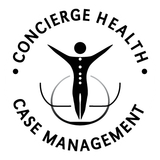Our Core Services
What we do
Concierge Health Case Management provides a structured approach to patient health risk management through identifying hazards (like medication errors or infections), assessing their impact, and implementing proactive strategies for prevention, mitigation, and acceptance. Our emphasizes are ongoing training, clear communication, thorough incident reporting, patient education, safety checklists for surgery, fall prevention programs, medication safety practices, and specialized nutritional resources, all aimed at enhancing patient safety and improving healthcare quality.
Comprehensive Risk Assessment
We recognize potential health risks in patients at an early stage, thereby improving both safety and the quality of care provided.
Proactive Mitigation Strategies
We implement targeted preventive measures and responsive protocols, reducing complications and healthcare costs.
Patient Education and Communication
We empower patients with knowledge, increasing adherence to health guidelines, trust, and overall satisfaction.

Comprehensive Risk Assessment
We identify potential risks to patient health, then implement measures to reduce the likelihood of those risks occurring or lessen their impact if they do happen. We strive to improve patient safety and quality of care; this often involves steps like thorough risk assessment, preventive measures, training, and contingency planning.
Identification
Actively identifying potential hazards in patient care, including medication errors, infection control issues, surgical complications, and adverse reactions to treatments.
Assessment
Analyzing the likelihood and potential severity of identified risks to prioritize which ones require most attention.
Assessment includes:
Prevention
Implementing proactive measures to prevent risks from occurring, such as double-checking medications, and proper patient monitoring.
Reduction
Taking steps to minimize the impact of a risk if it does occur, like having readily available medical supplies and equipment or well-trained staff to manage complications.
Acceptance
Acknowledging a risk that may be unavoidable but monitoring it closely and taking appropriate actions if necessary.

Medication Safety Checks
Double-checking medication orders and refills, adverse events and side effects and accessible medication administration.
Patient Fall Prevention
Assessing fall risk factors, implementing fall prevention strategies, and providing appropriate assistive devices.
Surgical Safety Checklists
Utilizing standardized checklists to ensure all necessary steps are taken before, during, and after surgery.
Patient Education
Providing patients with information about their conditions, potential risks, and how to manage their health effectively.
Available Resources for Nutrition and Dietary Needs
Providing patients with nutrition counselors, chefs and licensed physical therapy/personal training specialists.
Proactive Mitigation Strategies
Our key elements for managing health strategies
Identification
01
Actively identifying potential hazards in patient care, including medication errors, infection control issues, surgical complications, and adverse reactions to treatments.
02
Assessment
Analyzing the likelihood and potential severity of identified risks to prioritize which ones require most attention.
03
Patient Education and Training
Providing ongoing consulting on healthcare practices, including proper procedures, safety guidelines, and early recognition of potential risks.
04
Incident Reporting and Analysis
Encouraging caregivers to report any potential or actual adverse events, thoroughly investigating incidents to identify root causes and implement corrective actions.
05
Quality Improvement Initiatives
Continuously monitoring and evaluating patient care practices to identify areas for improvement and reduce risks.
Communication and Transparency
06
Open communication with patients and family members regarding potential risks, safety concerns and updates on health care strategies.

